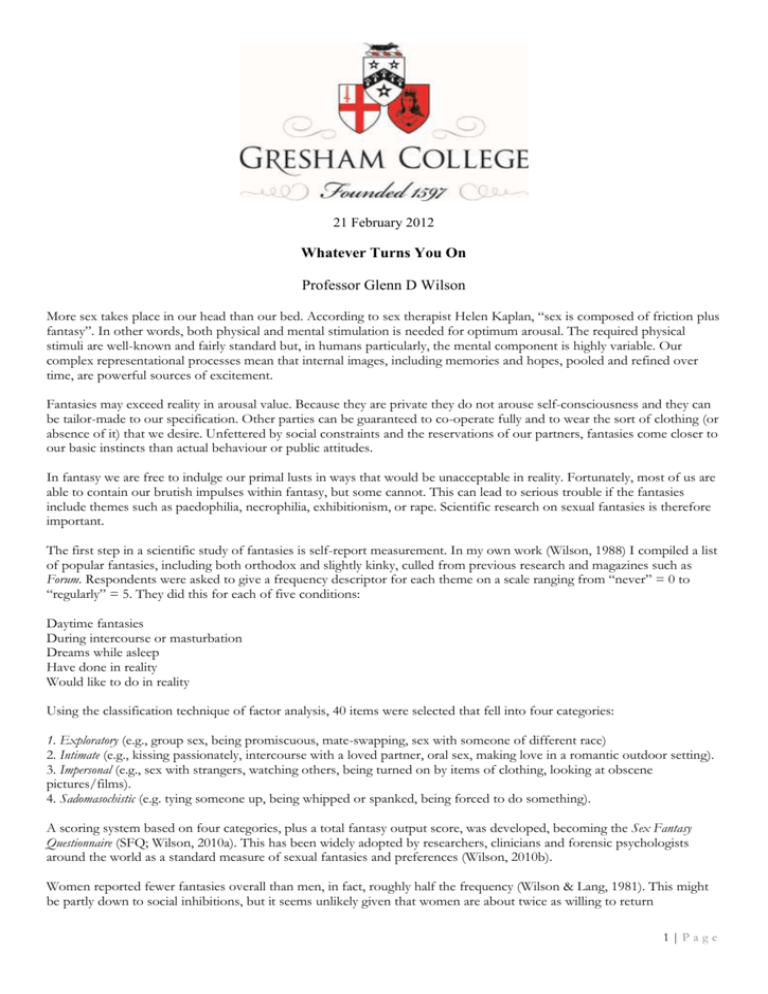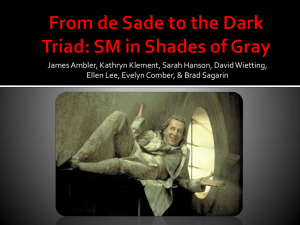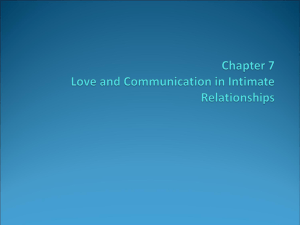
21 February 2012
Whatever Turns You On
Professor Glenn D Wilson
More sex takes place in our head than our bed. According to sex therapist Helen Kaplan, “sex is composed of friction plus
fantasy”. In other words, both physical and mental stimulation is needed for optimum arousal. The required physical
stimuli are well-known and fairly standard but, in humans particularly, the mental component is highly variable. Our
complex representational processes mean that internal images, including memories and hopes, pooled and refined over
time, are powerful sources of excitement.
Fantasies may exceed reality in arousal value. Because they are private they do not arouse self-consciousness and they can
be tailor-made to our specification. Other parties can be guaranteed to co-operate fully and to wear the sort of clothing (or
absence of it) that we desire. Unfettered by social constraints and the reservations of our partners, fantasies come closer to
our basic instincts than actual behaviour or public attitudes.
In fantasy we are free to indulge our primal lusts in ways that would be unacceptable in reality. Fortunately, most of us are
able to contain our brutish impulses within fantasy, but some cannot. This can lead to serious trouble if the fantasies
include themes such as paedophilia, necrophilia, exhibitionism, or rape. Scientific research on sexual fantasies is therefore
important.
The first step in a scientific study of fantasies is self-report measurement. In my own work (Wilson, 1988) I compiled a list
of popular fantasies, including both orthodox and slightly kinky, culled from previous research and magazines such as
Forum. Respondents were asked to give a frequency descriptor for each theme on a scale ranging from “never” = 0 to
“regularly” = 5. They did this for each of five conditions:
Daytime fantasies
During intercourse or masturbation
Dreams while asleep
Have done in reality
Would like to do in reality
Using the classification technique of factor analysis, 40 items were selected that fell into four categories:
1. Exploratory (e.g., group sex, being promiscuous, mate-swapping, sex with someone of different race)
2. Intimate (e.g., kissing passionately, intercourse with a loved partner, oral sex, making love in a romantic outdoor setting).
3. Impersonal (e.g., sex with strangers, watching others, being turned on by items of clothing, looking at obscene
pictures/films).
4. Sadomasochistic (e.g. tying someone up, being whipped or spanked, being forced to do something).
A scoring system based on four categories, plus a total fantasy output score, was developed, becoming the Sex Fantasy
Questionnaire (SFQ; Wilson, 2010a). This has been widely adopted by researchers, clinicians and forensic psychologists
around the world as a standard measure of sexual fantasies and preferences (Wilson, 2010b).
Women reported fewer fantasies overall than men, in fact, roughly half the frequency (Wilson & Lang, 1981). This might
be partly down to social inhibitions, but it seems unlikely given that women are about twice as willing to return
1|Page
questionnaires on the subject and that it applied even to Intimate fantasies. Of course, many of the fantasies experienced
by women may be so esoteric and romantic in nature that they are not even recognised as sexual.
The male preponderance of sexual fantasies is largely down to testosterone. Udry et al (1985) found that serum
testosterone levels predicted the frequency of fantasies in adolescent boys, whereas six other hormones did not. The same
was true for teenage girls (Udry et al, 1986). Women presenting with loss of libido at a Welsh clinic averaged around half
the number of fantasies on the SFQ as functional controls (Nyunt et al, 2002). Testosterone supplements for women
increase the amount of sexual fantasy, along with sex drive and activity, whereas anti-androgens given to men reduce both
fantasies and libido (Cooper et al, 1992). The SFQ Total Fantasy score correlates with the number of different partners
and is a good proxy for sex drive (Wilson, 2010a).
The fantasies of men and women differ in ways that are predictable from evolutionary theory. Parental investment theory
predicts that men would be more exploratory and interested in young, physically attractive, multiple partners than women,
who put a higher premium on the identity and social position of their partner and his willingness to commit to a
relationship. This is exactly what is found. Men incline towards visual/fetishistic (pornographic) scenarios, with novel,
ever-willing young partners; women are more likely to incorporate their regular partner into their fantasy or dream of an
identifiable, socially powerful (often famous) individual, who will sweep them off their feet with love and devotion
(Wilson, 1987; 1997).
Many SFQ items are paired in actor and recipient forms (e.g. whipping and being whipped, seducing an innocent, being
seduced as an innocent). This permits separate scoring for Active vs Passive fantasies. As expected, men were more active
in their fantasies than women (Wilson & Lang, 1981) a finding replicated in Japan (Iwawaki & Wilson, 1983). Men actually
report as many passive fantasies as women, so the gender difference is mostly due to the lower level of active fantasies in
women.
Fantasies seem to occupy different roles in the lives of men and women. Freud thought fantasies indicated a deficient
reality but this is more true for men than for women. When subjects were asked how sexually satisfied they were, there was
little overall relationship to fantasy output. However, looking at data separately for men and women revealed that while
dissatisfied men fantasised more than satisfied men, satisfaction in women went with higher levels of fantasy (Wilson,
1988). Alfonso et al (1992) also found that satisfied men had fewer fantasies, whereas satisfied women had more. It seems
that men who are deprived (e.g., in prison or without partners) fantasise more, mostly in connection with masturbation,
while women’s fantasies are “awakened” by an active sex life (Cogan et al, 2007).
Sexual fantasies and actual behaviour are positively related. People generally do the things they fantasise about. Again, this
is particularly true for women (Hsu et al, 1994). This may be because women’s fantasies are more often derived from
experience. It could also mean that women can more easily find partners willing to oblige them in their special desires,
whereas men may need to visit a professional.
Do couples share their fantasies? Only a minority do: 26% of men and 32% of women according to Davidson (1985). No
doubt it depends on the content of the fantasy and whether it involves the partner or someone else. In a survey conducted
across several countries (Buunk & Hupka, 1987) most people, women especially, claimed they would not feel jealous if
their partner told them about their sexual fantasy, even if it was about another person. As the Duke of Wellington might
say: “If you believe that, you’d believe anything.”
When free narrative fantasies are obtained, rape/force is surprisingly high on the female list. Wilson (1987) found 13% of
women reporting rape/force as their No 1 favourite fantasy, while around 50% have force fantasies at least occasionally
(Strassberg & Lockerd, 1998). Of course, this does not mean that women subconsciously want to be raped. One of the
functions of fantasy is to rehearse reactions to exceptional events and rape fantasies might help with coping. Plus, there
may be a catch-22 involved: women might want to be raped, but only by a man they would like to rape them, not the
stranger in the park who presents a knife. They probably have in mind something more like an abduction by the Sheik of
Araby as portrayed by Rudolph Valentino.
It has been argued that force fantasies are a way in which women raised under strict prohibitions can deal with guilt about
their sexual desires. If the sexual activity a woman imagines is not of her doing she can feel blameless. However, this is not
supported by the finding that force fantasies are most common in sexually active, liberated women. In fact, female
submission fantasies may actually be more about power than weakness, because the woman sees herself irresistibly
attractive (Leitenberg & Henning, 1995).
Could force fantasies derive from a history of childhood sexual abuse? Evidence here is mixed. Briere et al (1994) found
that women who were sexually abused in early childhood had more fantasies of being forced to have sex than non-abused
2|Page
women. Covarrubias (1996) found that force fantasies were unrelated to sexual satisfaction in abused women. However,
non-abused women who reported force fantasies were more satisfied, suggesting that such fantasies are not necessarily
unhealthy. Perhaps the effect of childhood abuse depends on how it was experienced at the time, whether as
arousing/pleasurable or distressing/traumatic (c.f., Sabine in A Dangerous Method).
One might suppose that men who fantasise about being dominated by women would be few and far between, yet this is
also a popular predilection (Gosselin & Wilson, 1980). Interestingly, such men are often among society’s most powerful in
everyday life (judges, headmasters, etc). These are successful men forced to behave in rigid, respectable ways on a day to
day basis, being constantly required to make decisions and exude confidence in their abilities. They appear to take pleasure
in briefly relinquishing control and becoming totally subservient to a dominatrix, perhaps donning female clothes and
being humiliated. The total role reversal seems to work like a holiday, bringing relief from everyday stress (Baumeister,
1988).
Where do the details of such strange inclinations originate? Punishment may be sexually exciting because there is overlap
between different types of arousal. Fear, aggression and sexual excitement share an adrenaline surge and hence amplify
each other. Being whipped or spanked may redistribute the blood supply toward the genitals, directly enhancing sexual
tumescence. Then there is the release of endorphins (internally generated morphine-like substances) that enter the brain to
combat pain but leave a “high” after the punishment is abruptly stopped. It is possible that for some men there is an
element of expiation, like the monks who practice self-flagellation to atone for their “sins”.
Other subconscious factors may also at be work. A desire to be dominated may derive from the time in infancy when
mother is the main disciplinarian. Punishment scenarios or “scripts” may be imprinted by association with the earliest
stirrings of sexual arousal. Some men revisit infancy by wearing nappies and crawling about the floor, but for those who
enjoy being tied up, spanked, immersed in rubber, or making love to a high-heeled shoe, there are also regressive elements.
Shoe fetishism is more common than hat fetishism, perhaps because shoes are more salient in the sightline of a crawling
infant (Gosselin & Wilson, 1980). Not surprisingly, men seldom indulge these urges at home but visit a prostitute who
provides such services. Most do not seek treatment because they have no wish to change.
The widespread availability of variant sexual preferences has been used to help locate the brain regions involved in sexual
excitement. Waismann et al (2003) devised a variance quotient using the formula: VQ = (Impersonal +
Sadomasochistic)/(Intimate + Exploratory) to measure paraphilic tendencies. Evoked potentials in the EEG to normal vs
variant stimuli, revealed the P600 component (the positive voltage change occurring 600 msecs after the appearance of the
stimulus) as the best marker of erotic preferences. Reactions were strongest in the P4 (right parietal brain region) for
normal men viewing standard heterosexual images and the F3 (left frontal area) for variant men viewing paraphilic images.
This finding suggests that paraphilic men depend more on verbal/social scripts for sexual arousal than normal men, who
are more responsive to basic visual stimuli.
The VQ has been used to investigate neurodevelopmental correlates of paraphilic interests in men. Rahman & Symeonides
(2008) found that paraphilic men had a greater number of older brothers, feminised 2D:4D finger ratios, and a tendency to
left-handedness compared to conventional heterosexual men. The neurodevelopmental history of paraphilic men is thus
similar in some ways to homosexual men and possibly indicates lower exposure to prenatal testosterone.
When are fantasies dangerous? The sheer prevalence of sadomasochistic fantasies in the general population, together with
the apparent lack of pathology in most of those who report them (Wilson & Gosselin, 1980), suggests that overall risk
levels are low. Criminal sadists often show a pattern of escalating fantasy and behavioural rehearsals prior to committing
serious offences (MacCulloch et al, 1983) but their erotic targets are unwilling victims from the outset (Grubin, 1994).
Criminal sadists differ from S/M enthusiasts in several ways: (1) They tend to come from the ranks of low-level itinerant
occupations, such as bouncers, barmen, wheel-clampers and amusement park workers, whereas S/M enthusiasts come
more from creative and professional occupations. (2) They plan their crimes meticulously, directing their attention toward
locating, abducting, restraining and torturing unwilling victims and making no effort to find partners who would cooperate in their fantasies. (3) They are inclined to be cold and brutal, lacking in ceremony, symbolism and “theatre” (Dietz
et al, 1990).
The SFQ has found application in risk assessment with sexual offenders. Child molesters are distinguished from nonsexual offenders by high scores on the Exploratory and Intimate scales but not the Impersonal or S/M factors
(Baumgartner et al (2002). Both offender groups showed what amount to low VQ scores as well as lower overall scores
compared to college students and non-criminal variant groups This could be due to under-reporting by offenders, who
might reasonably be concerned about the parole implications of their responses. Against that, Smith et al (2005) found that
high-risk (as opposed to low-risk) adolescent sexual offenders scored higher on all SFQ scales.
3|Page
A particularly telling study is that of Hudson et al (2002). They gave a large battery of psychometric tests to men
incarcerated for sexual molestation, in order to see which would predict recidivism after release. The SFQ Impersonal and
S/M scores emerged as the best predictors, but only for pre-treatment scores (after treatment the correlations
disappeared). This suggests that any “improvement” following treatment was illusory. The more the deviant fantasies
seemed to have been cured, the more likely was the individual to reoffend. Were they deceiving themselves, or just the
authorities? This is a cautionary finding with respect to the evaluation of “therapy” for sexual offending and the
assessment of future risk.
Erectile responses to visual images are considered to be relatively free of susceptibility to faking but these are also
problematic. Barabee & Marshall (1989) found that around 35-40% of convicted male child molesters were more aroused
by images of children than adults, while another 15% were equally aroused by children. No controls showed greater
arousal to children than adults, though 18% showed equal arousal. The plethysmograph may therefore be a useful adjunct
to self-reported fantasies, though it too is open to faking and suppression of response.
There is considerable doubt as to whether rapists are distinguishable from normal men as regards erectile arousal to rape
scenes. A small proportion of rapists are specifically turned by the resistance of their victim but most would prefer a
consenting woman. The real problem with rapists is their failure to recognise, or be deterred by, the cues of refusal
(Leitenberg & Henning, 1995). Some perceive the refusal as insincere, some believe she will eventually change her mind if
they persist, and others simply don’t care.
Erectile responses to images supplied by the researcher tell us little about what offenders fantasise about in their daily life
Leitenberg & Henning (1995). They do not prove that deviant fantasies are more common in offenders than men at large,
nor that they are instrumental in precipitating their crimes. Clinical evidence confirms that sexual sadists and other
offenders do usually have masturbatory fantasies relating to their crimes but that does not prove the fantasy was the cause
of the crime. Sometimes the fantasy is a recollection of the crime, rather than a prompt. It also needs to be remembered
sadistic fantasies occur in men who never commit sexual crimes.
It is unclear that fantasies are a necessary or sufficient cause of child molestation, rape or murder. Most people do not
cross the boundary between deviant fantasy and reality. Other risk factors, need to be considered, including the persistent,
obsessional, and escalating nature of the fantasy, dysfunctional family history, and personality/attitude factors such as
hostility towards women, lack of victim empathy, feelings of impotence, loneliness and inadequacy. Fantasies in
themselves are seldom toxic.
When I began my studies of sexual fantasy some of my colleagues were dismissive of the field as frivolous and prurient.
Hence I shall conclude with summaries of three court cases I was involved with, that I believe illustrate the significance of
the field.
1. In 2000, West Midlands Police acquired transcripts of two paedophiles plotting to drive around in a van looking for
young girls (aged 2-10) to abduct, rape and murder. Their defence was that they were just fantasising these events, so I was
called to assess whether their conversations could be mere fantasy. My conclusion was that they were intending actual
abductions. One indication was the lack of “airbrushing”; whereas fantasy would dwell on the positive, erotic aspects of
the scenario, they were more concerned about practical details and difficulties, such as where to obtain Hypnol, the need
for their van to have a sliding door on the side to get the child in quickly, and the dangers of keeping the girl for too long.
Faced with this testimony, the two men changed their plea to guilty and were given long sentences.
2. In 2002 a Brighton man was tried for strangling a young woman to death, his defence being that she died accidentally in
the course of mutually consenting “breath play”. He had confided his interest in bondage and asphyxia to three previous
partners and non-lethal activities of this kind had occurred with each. Nevertheless, I found his defence unpersuasive
because he hardly knew the particular victim and had a well-documented hatred of women. One ex girl-friend reported
that he said “he feared he might strangle and kill a woman” (shortly before punching her gratuitously in the face). A
doctor’s case notes, 12 years earlier, referred to “violent thoughts toward women in general, including thoughts of
murdering them”. It did not help his case that he concealed the corpse for some weeks in the Big Yellow Storage facility,
visiting it several times to take it out and view (suggesting necrophile interests) before eventually taking it up to the hills to
burn it. The jury was unimpressed and found him guilty of murder.
3. The third case concerned a young man who was charged with the frenzied knife murder of a young mother in front of
her child on Wimbledon Common in 1993. The prosecution claimed his sexual fantasies were so similar to the details of
the crime, and his fit to the theoretical profile of the killer so perfect, that the chances of anyone else being responsible
were “vanishingly small”. I was able to testify that his fantasies were actually quite common in the male population at large
and, anyway, they had been “shaped” by the female police officer who befriended him in order to extract a confession. He
4|Page
was a virgin at the time, and she indicated that she would have sex with him if he could only get the fantasies right. He
never did confess to the Wimbledon murder, though he made up details of a non-existent one to try to satisfy her. The
judge agreed with my assessment that the case was unsatisfactory and threw it out before the trial even commenced
(though not before the young man had spent over a year in prison). The tabloid press continued to give the impression
that he had escaped on a technicality and it was not until another man was convicted on solid DNA evidence that they
apologised for the way they had hounded him.
© Glenn D Wilson 2012
References
Alfonso, V.C. et al (1992) Sexual fantasy and satisfaction: A multidimensional analysis of gender differences. Journal of Psychology
and Human Sexuality, 5, 19-37.
Barabee, H.E. & Marshall, W.L. (1989) Erectile responses among heterosexual child molesters, father-daughter incest offenders
and matched non-offenders: Five distinct age preference profiles. Canadian Journal of Behavioural Sciences, 21, 70-82.
Baumeister, R.F. (1988) Gender differences in sadomasochistic scripts. Journal of Sex Research, 25,478-499.
Baumgartner, J.V. et al (2002) Assessment of the Wilson Sex Fantasy Questionnaire among child molesters and non-sexual
forensic offenders. Sexual Abuse: A Journal of Research and Treatment, 14, 19-29.
Briere, J. et al (1994) Sexual fantasies, gender and molestation history. Child Abuse and Neglect, 13, 65-75.
Buunk, B. & Hupka, R.B. (1987) Cross-cultural differences in the elicitation of sexual jealousy. Journal of Sex Research, 23, 12-22.
Cogan, R. et al (2007) Sexual fantasies, sexual functioning and hysteria among women: A test of Freud’s (1905) hypothesis.
Psychoanalytic Psychology 24, 697-700.
Cooper, A.J. et al (1992) A double-blind controlled trial of medroxyprogesterone acetate and cyproterone acetate with seven
paedophiles. Canadian Journal of Psychiatry, 37, 687-693.
Covarrubias, L.D. (1996) The relationship among disposition toward fantasy, force fantasies, sexual dysfunction, satisfaction and
female sex abuse history. Dissertation Abstracts, DAI-B 57/07, 4700.
Davidson, J.K. (1985) The utilisation of sexual fantasies by sexually experienced university students. Journal of American College
Health, 34, 24-32.
Dietz, P.E. et al (1990) The sexually sadistic criminal and his offences. Bulletin of the American Academy of Psychiatry and the Law. 18,
163-178.
Gosselin, C.C. & Wilson, G.D. (1980) Sexual Variation. London: Faber & Faber.
Grubin, D. (1994) Sexual sadism. Criminal Behaviour and Mental Health, 4, 3-9.
Hsu, B. et al (1994) Gender differences in sexual fantasy and behaviour in a college population: A ten year replication. Journal of
Sex and Marital Therapy, 20, 103-118.
Leitenberg, H. & Henning, K. (1995) Sexual fantasy. Psychological Bulletin, 469-496.
Iwawaki, S. & Wilson, G.D. (1983) Sex fantasies in Japan. Personality and Individual Differences, 4, 543-545.
MacCulloch et al (1983) Sadistic fantasy, sadistic behaviour and offending. British Journal of Psychiatry, 143, 20-29.
Hudson, et al (2002) Dynamic risk factors: The Kia Marama evaluation. Sexual Abuse: A Journal of Research and Treatment, 14, 103119.
Nyunt, A. et al (2002) Androgen status and female sexual dysfunction in healthy premenopausal women. Endocrine Abstracts, 3,
222.
Rahman, Q. & Symeonides, D.J. (2008) Neurodevelopmental correlates of paraphilic sexual interests in men. Archives of Sexual
Behaviour, 37, 166-172.
Smith, S. et al (2005) Differences in self-report measures by adolescent offender risk groups. International Journal of Offender
Therapy and Comparative Criminology, 49, 82-106.
Strassberg D.S. & Lockerd, L.K. (1998) Force in women’s sexual fantasies. Archives of Sexual Behaviour, 27, 403- 414.
Udry, D.R. et al (1985) Serum androgenic hormones motivate sexual behaviour in adolescent boys. Fertility and Sterility, 43, 90-94.
Udry, D.R. (1986) Biological foundations for adolescent female sexuality. Demography, 23, 217-227.
Waismann, R. et al (2003) EEG responses to visual erotic stimuli in men with normal and paraphilic interests. Archives of Sexual
Behaviour, 32, 135-144.
Wilson, G.D. (1987) Male-female differences in sexual activity, enjoyment and fantasies. Personality and Individual Differences, 8,
125-127.
Wilson, G.D. (1988) Measurement of sex fantasy. Sexual and Marital Therapy, 3, 45-55.
Wilson, G.D. (1997) Gender differences in sexual fantasy: An evolutionary analysis. Personality and Individual Differences, 22, 27-31.
Wilson, G.D. & Lang, R.J. (1981) Sex differences in sexual fantasy patterns. Personality and Individual Differences, 2, 343-346.
Wilson, G.D. (2010a) Wilson’s Sex Fantasy Questionnaire (SFQ). Cymeon, Sydney.
Wilson, G.D. (2010b) The Sexual Fantasy Questionnaire: An update. Sexual and Relationship Therapy, 25, 1-5.
Wilson, G.D. & Gosselin, C. (1980) Personality characteristics of fetishists, transvestites and sadomasochists. Personality and
Individual Differences, 1, 289-295.
5|Page








